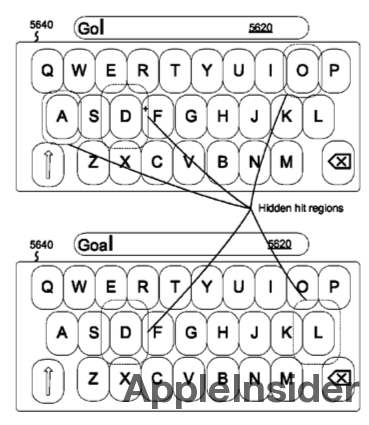Apple on Tuesday was granted a U.S. patent for the graphical user interface used in iOS which changes the "hit region" size of a virtual keyboard's buttons based on predictive text data.
In an elegant solution to the problem of entering text on a mobile device's small screen, Apple's U.S. Patent No. 8,232,973 for a "Method, device, and graphical user interface providing word recommendations for text input" enlarges the effective area of the virtual keyboard's buttons based on a predictive input system without resizing the visual keyboard asset.
For example, a user entering the word "ELEPHANT" would begin by hitting the "E" key followed by the "L" key, the "E" key and so on. The system begins to narrow down what the user is attempting to spell, dynamically increasing the size of the next expected key icon which in this example would be the "P" key. Instead of representing the next key's larger hit area visually, the keyboard retains its normal size which makes the system completely invisible to the user.
The '973 patent most likely leverages technology from Apple's U.S Patent No. 8,074,172 for a "method, system, and graphical user interface for providing word recommendations" or predictive text.
Working in concert with the enlarged image users see above an iOS keyboard's key when a touch event is recorded, the predictive technology provides for a smooth and user-friendly solution to typing on a small device.
Apple notes the invention is an attempt at a more efficient method of entering text into small portable devices. The company points out that the capabilities of "portable communications devices have increased dramatically," alluding to an increasing reliance on text messaging services like SMS, instant messaging or e-mail.
"However, the size of these portable communication devices also restricts the size of the text input device, such as a physical or virtual keyboard, in the portable device," the patent reads. "With a size-restricted keyboard, designers are often forced to make the keys smaller or overload the keys. Both may lead to typing mistakes and thus more backtracking to correct the mistakes. This makes the process of communication by text on the devices inefficient and reduces user satisfaction with such portable communication devices."
The '973 patent was first filed for in June of 2008, less than two weeks prior to the debut of Apple's second-generation handset, the iPhone 3G.

Illustration of Apple's predictive text input UI patent. | Source: USPTO
From the abstract:
A portable electronic device having a touch screen display performs a set of operations, including displaying a plurality of key icons, each having an adjustable size hit region, and receiving a sequence of individual touch points input by a user on the touch screen display. The operations performed by the device further include processing the received individual touch points by: forming a user-input directed graph for the sequence of individual touch points received so far, determining a character corresponding to a last received individual touch point in accordance with the adjustable hit regions of the displayed key icons, displaying a sequence of characters corresponding to the sequence of individual touch points, and updating sizes of the adjustable hit regions for a plurality of the key icons in accordance with the sequence of individual touch points input by the user.
Among those credited as inventors is Apple Senior Vice President of iOS Software Scott Forstall.


